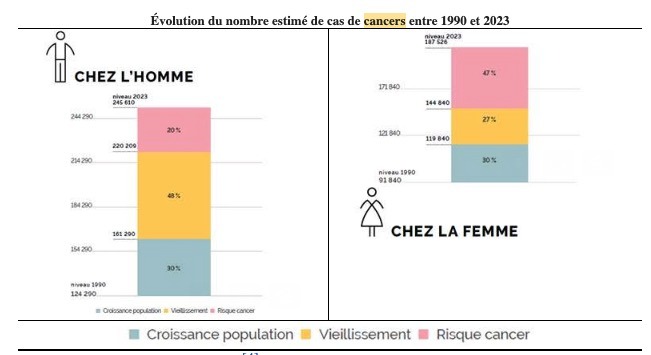Published on
Updated
Reading 4 mins.
For three years now, the National Cancer Institute (InCa) has published its “Panorama of cancers” which brings together all the data on the disease. Consisting of three chapters, the document brings together the general epidemiology of the main types of cancer, data by gender and disease prevention strategies.
For the third consecutive year, InCa is publishing its “Panorama of cancers”, a comprehensive document which condenses the general epidemiology of the disease and more targeted data on men and women and reviews prevention strategies. A work for which the InCa is associated with Santé Publique France, the Hospices de Lyon and Francim, the French network of cancer registries.
The 3 factors behind the increase in new cases
In the first part of the document, mention is made of “projection data for the number of new cancer cases, which amount to 433,136 for all locations“. So, “compared to the latest incidence data (for the year 2018 and published in 2019), this corresponds to more than 51,000 new cases of cancer in 2023“says the report.
How is this increase explained? “There are three factors to consider” explains Dr. Tania D’Almeida, co-coordinator of the incidence study and attached to Francim, the French network of cancer registries. “This increase is mainly linked to the increase and the aging of the population without forgetting, as a third factor, the increase in the risk of occurrence of cancer.. Among the main risk factors are, unsurprisingly, tobacco, alcohol and lack of physical activity.
The first two causes – the increase and the aging of the population – alone explain 78% of the increase in the number of cases in men and 57% in women. Moreover, notes the Panorama, “the median age at diagnosis has increased from 67 to 68 years in women and from 68 to 70 years in men”.

Which cancers are increasing or decreasing?
This panorama also identifies the cancer sites for which the average annual variation increases or decreases over the period between 1990 and 2023.
In men there is a decrease for:
- Lip-mouth-pharynx cancers (- 2.6% per year);
- Esophageal cancers (-2.7% per year);
- Stomach cancers (-2.2% per year);
- Colorectal cancer (-0.3% per year);
- Lung cancer (- 0.2% per year).
Conversely, there is an increase for melanoma (skin cancer) (+ 3.5% per year), pancreatic cancer (+ 2.3% per year) or liver cancer (+ 1.3 % per year).
In women, there is a decrease for:
- Stomach cancer (-1.6% per year);
- Cervical cancer (-1.4% per year);
- Ovarian cancer (- 1.1% per year).
On the other hand, a “worrying” increase is observed for lung cancer (+ 4.3% per year). Just like those of liver and pancreatic cancers with respectively + 3.2% and + 3.3% per year.
According to Dr. Florence Molinié, President of Francim, “concerning the difference in incidence between men and women on lung cancer, and the worrying increase in women, the major factor is tobacco consumption. It increased in women later than in men. Effects now appear with a time lag”.
For the reduction of ovarian cancer in women, “there is a hypothesis linked to the increase in hormonal contraception which would be protective against ovarian and endometrial cancer (unlike the effect on breast cancer). Generations of women ( years 1960-70) having started to use contraceptives more frequently would explain this continuous decline in ovarian cancer for several years” adds Dr. Molinié.
Prevention, a key factor in limiting risks
To fight against the appearance of cancer and limit its impact once installed, the InCa report insists on prevention.
- Primary prevention: “Nearly half of cancers could be prevented by quitting smoking, respecting guidelines for alcohol consumption, eating a balanced and varied diet and practicing regular physical activity“;
- Secondary prevention: screening promotes “early detection of the disease, increasing the chances of recovery and reducing the sequelaeWith this in mind, InCa is currently working on setting up a pilot program to screen for bronchopulmonary cancer in smokers and former smokers.
Asked about this, Professor Norbert Ifrah, President of the National Cancer Institute, explains the approach: “We are currently working on the form that this screening for lung cancer could take, which must be accompanied by work on weaning assistance. Because we don’t want to reproduce what happened in the United States: there was enthusiasm for the first screening, but people, being reassured by a negative result, took it as an encouragement to continue smoking. The rate of responses to new invitations collapsed and was subsequently around 6%. This is what we absolutely want to avoid“.
Regarding existing screenings, Santé Publique insists on the need to increase their participation:
- Only 47.7% of women over the 2021-2022 period participated in breast cancer screening;
- 58.8% participate in cervical cancer screening (period 2018-2020) – a participation which reaches a good level, but which decreases with age;
- For colorectal cancer screening, which concerns both men and women, participation is only 34.3% (2021-2022). Online ordering and the possibility of collecting the screening kit from the pharmacist will facilitate access to this program and contribute to increasing participation.
Care: the use of immunotherapy on the rise
While surgery remains the first treatment for cancer, 419,050 patients have benefited from it, the use of new specific immunotherapy treatments is progressing alongside traditional treatments. Thus, in 2021, 62,633 patients were treated with checkpoint inhibitors (+21% compared to 2020) and 505 with CART-T cells (+36% compared to 2020).
Cancerology activity represents more than a quarter of hospital activity with 7.76 million hospitalizations recorded in 2021 for an expenditure budget amounting to 6.3 billion euros in 2021 (i.e. an increase of 6 .6% compared to 2020).
